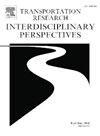Enhancing emergency response efficiency through advanced urban logistics: The role of driver psychophysiology and vehicle dynamics in mitigating socio-economic impacts
IF 3.9
Q2 TRANSPORTATION
Transportation Research Interdisciplinary Perspectives
Pub Date : 2025-05-01
DOI:10.1016/j.trip.2025.101464
引用次数: 0
Abstract
Urban emergencies, such as natural disasters and public safety incidents, demand rapid and effective response strategies to mitigate their significant socio-economic impacts. This paper explores the complex interplay between urban logistics and the operational efficiency of emergency services, focusing on the critical roles of driver psychophysiology and vehicle dynamics. We conducted a comprehensive study analysing the movement patterns of emergency response vehicles in urban settings, taking into account factors such as vehicle speed variations, route parameters, and the psychophysiological states of drivers. Utilising regression models and physiological assessments, we developed predictive models that link these factors to emergency response times. The findings indicate that the speed and efficiency of emergency responses are significantly influenced by the drivers’ conditions, highlighting the importance of psychophysiological readiness in emergency operations. By integrating quantitative and qualitative methodologies, this research not only enhances our understanding of these dynamics but also provides actionable strategies to improve the efficacy of emergency services. The outcomes of this study have practical implications for policy formulation and the operational structuring of emergency units, emphasising the need for strategic planning that incorporates driver welfare and advanced logistics management. This work lays a foundation for future research aimed at integrating real-time data analytics and sophisticated routing algorithms to further refine emergency response mechanisms in urban environments.
通过先进的城市物流提高应急响应效率:驾驶员心理生理学和车辆动力学在减轻社会经济影响中的作用
城市紧急情况,如自然灾害和公共安全事件,需要迅速和有效的应对战略,以减轻其重大的社会经济影响。本文探讨了城市物流与应急服务运行效率之间的复杂相互作用,重点关注驾驶员心理生理和车辆动力学的关键作用。我们进行了一项综合研究,分析了城市环境下应急车辆的运动模式,考虑了车辆速度变化、路线参数和驾驶员的心理生理状态等因素。利用回归模型和生理评估,我们开发了将这些因素与应急响应时间联系起来的预测模型。研究结果表明,应急响应的速度和效率受到驾驶员状况的显著影响,突出了心理生理准备在应急行动中的重要性。通过整合定量和定性方法,本研究不仅增强了我们对这些动态的理解,而且还提供了可操作的策略来提高应急服务的效率。这项研究的结果对应急单位的政策制定和业务结构具有实际意义,强调了将驾驶员福利和先进物流管理结合起来的战略规划的必要性。这项工作为未来旨在整合实时数据分析和复杂路由算法的研究奠定了基础,以进一步完善城市环境中的应急响应机制。
本文章由计算机程序翻译,如有差异,请以英文原文为准。
求助全文
约1分钟内获得全文
求助全文
来源期刊

Transportation Research Interdisciplinary Perspectives
Engineering-Automotive Engineering
CiteScore
12.90
自引率
0.00%
发文量
185
审稿时长
22 weeks
 求助内容:
求助内容: 应助结果提醒方式:
应助结果提醒方式:


